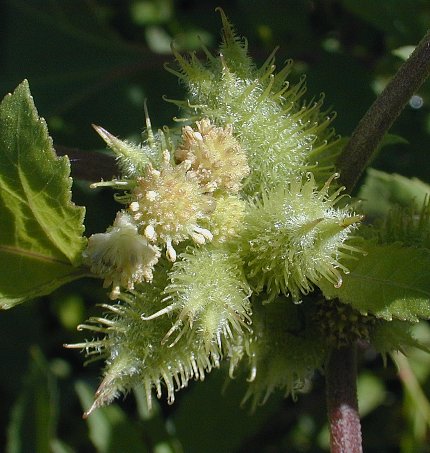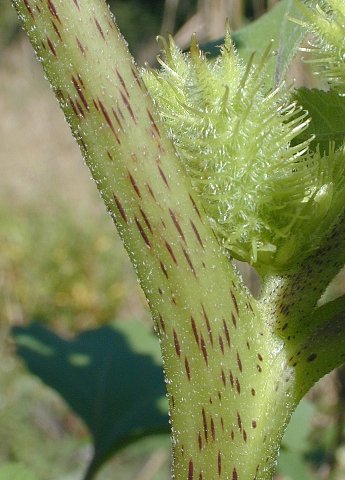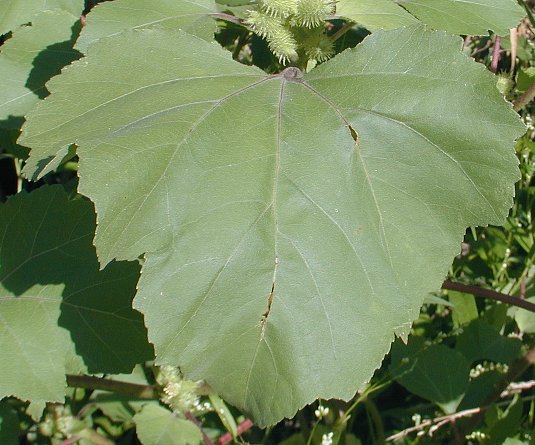Description: This plant is a summer annual that becomes about 2-4' tall; it is little branched, except for short side stems developing from the leaf axils. The stems are round or slightly ribbed. They are often speckled with purple and have short white hairs scattered across the surface. The alternate leaves are up to 8" long and 6" across. They are cordate or ovate-cordate with bases that are well-rounded or indented and tips that are broad and blunt. Their margins are shallowly lobed or coarsely toothed, while the upper surface has a sandpapery texture. Each leaf has a long petiole that is often reddish or reddish green and about as long as the leaf blade. The petioles usually have short white hairs. A single spike-like raceme of compound flowers develops from the axil of each upper leaf. These racemes are shorter than the petioles of the leaves, often 1-4" in length. In addition, the central stem terminates in a spike-like raceme that is similar to the racemes of the leaf axils. Because Common Cocklebur is monoecious, each raceme produces several male compound flowers along its upper half, while several female compound flowers occur in the lower half.

The male compound flowers are about ¼" across, consisting of numerous staminate florets that have stamens with prominent white anthers. Each male compound flower occurs on a short pedicel and is slightly rounded at the top, while at the base there are 1-3 series of white floral bracts. After shedding their pollen, the male flowers quickly fade away. The female compound flowers are up to 1½" long and 1" across. Each female compound flower contains 2 pistillate florets, which are nearly enclosed by a prickly floral bract with a bur-like appearance. The female compound flowers are initially green, but turn brown as they mature and are slow to detach from the racemes. They are sessile or have short petioles. The surface of the floral bract is covered with curly white hairs, while the prickles are hooked at their tips. At the apex of each bur, there are a pair of spines that are longer and more stout than the prickles. At the base of each spine, there is a small opening for the divided style of a female flower. These styles are inconspicuous and wither away in a short period of time. The blooming period occurs during the late summer or early fall, although some plants may bloom a little earlier or later. Pollination is by wind and there is no floral scent. Each female flower within the bur-like bract produces a single oblong seed that more or less tapers to a point at each end. The seeds are often covered with dark membranes. One of the seeds in each bur has the capacity to germinate the following year, while the the germination of the second seed is delayed for at least 2 years. The root system consists of a taproot that is stout and rather woody. This plant reproduces by reseeding itself, and often forms colonies.

Cultivation:
The
preference is full or partial sun, moist to mesic soil, and loamy or
sandy soil. Occasional flooding is tolerated if it is not too
prolonged. Young seedlings of Common Cocklebur exude toxic chemicals
that can inhibit germination of other species of plants, or kill off
their seedlings. Individual plants become less toxic as they mature.
Range & Habitat:
Common Cocklebur occurs in most counties of Illinois, where it is quite
common (see Distribution
Map).
The included map combines the distribution of the different varieties
(or species) of Common Cocklebur that have been described by some
authors. This plant is native to both North America and Eurasia.
Habitats
include cropland (especially corn fields), fallow fields, the
floodplain zone of rivers and ponds, degraded meadows that are poorly
drained, dried-up mudholes, partially stabilized areas of beaches and
sand dunes,
vacant lots, and waste areas. Disturbed, poorly drained areas are
preferred.

Faunal Associations: The flowerheads rely on the wind, rather than insects, to cross-pollinate individual plants. Insects that feed on Common Cocklebur include the Ragweed Leaf Beetle (Ophraella communa), stem-boring larvae of the Sunflower Longhorn Beetle (Dectes texanus), stem-boring larvae of the Sunflower Stem Weevil (Cylindrocopturus adspersus), Five-spotted Billbug (Rhodobaenus quinquepunctatus), Thirteen-spotted Billbug (Rhodobaenus tredecimpunctatus), stem-boring larvae of several tumbling flower beetles (Mordellistena spp.), larvae of leaf-miner flies (Calycomyza platyptera, Liriomyza trifolii), larvae of the Bur-Seed Fly (Euaresta aequalis), Spotted Green Plant Bug (Ilnacora stalii), a leaf-feeding aphid (Capitophorus xanthii), stem-boring larvae of the Ragweed Borer Moth (Epiblema strenuana), and seed-eating larvae of a moth, the Pale-headed Phaneta (Phaneta ochrocephala); see Charlet & Gavloski (2011), Vaurie (1983), Ford & Jackman (1996), Spencer & Steyskal (1986), Marshall (2006), Knight (1941), Robinson & Bradley (1965), and Miller (1987). The seedlings and seeds of Common Cocklebur are highly toxic to mammalian herbivores, including cattle, horses, sheep, and pigs (Masvingwe & Mavenyengwa, 1998). The foliage of more mature plants is less toxic, although the fatal poisoning of calves has been reported from its consumption (Witte et al., 1990). When cattle and horses feed on mature plants with burry fruits and flowers, this can cause obstruction of the gastrointestinal tract if they are eaten in sufficient quantity. White-tailed Deer occasionally chomp off the upper half of mature plants before the bur-like flowers develop (personal observation). Because the burry fruits readily cling to the fur of mammals and the clothing of humans, they are easily transported to new areas, spreading the seeds of this plant. Even though the seeds are regarded as highly toxic, there are records of their consumption by the Franklin Ground Squirrel, Prairie Deer Mouse, Purple Finch, and extinct Carolina Parakeet (Martin et al., 1951/1961; Whitaker, 1966; Snyder, 2004).

Photographic
Location:
The floodplain zone of a large drainage ditch in Judge Webber Park in
Urbana, Illinois.
Comments:
Common
Cocklebur (Xanthium
strumarium) resembles Common Burdock (Arctium
minus)
somewhat, but it has separate male and female flowers that are brownish
white and green, respectively, while the latter species has perfect
flowers with bright pink corollas. Because Common Cocklebur is a highly
variable plant, different varieties have been described (or even
regarded as distinct species by some authors), although the validity of
these different varieties (or species) has not been accepted by some
authorities (e.g., ITIS). For this reason, they will not be discussed
further. Another species that is
adventive from southwestern USA, Spiny Cocklebur (Xanthium
spinosum), is uncommon in Illinois. Compared to Common
Cocklebur, it has more
narrow lanceolate leaves and its petiole bases have solitary tripartite
spines.